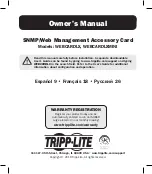
Digicast Media Router S2 Receiver CMR-5995 (MR-S2-ASI)
Revision 1
Configuring and Controlling the Digicast CMR
‑
5975 Media Router with SNMP
MN-CMR5995-IOM
E–3
E.3
SNMP and Digicast Products
Digicast products may be managed using numerous protocols:
Connection Oriented Protocols
Connectionless Protocol
Web (Hypertext Transport Protocol)
SNMP
Terminal
Telnet
SNMP is an IP management tool that can be used to provide remote management for
communications products. The SNMP protocol is a manager/agent-based design, where a
manager oversees multiple agents (or remotes).
Unlike connection-oriented protocols, the SNMP protocol is based on a connectionless-oriented
design, where data is exchanged between the manager and agent in a “best effort” manner – if a
packet is lost, it will not be retransmitted. SNMP uses a packet structure known as a Protocol
Data Unit (PDU) that uses the User Datagram Protocol (UDP) for sending information over an
IP-enabled network.
There are currently three versions of SNMP in existence:
1.
SNMP version 1 (SNMPv1)
was the first version and is the most widely used today.
However, SNMPv1 has serious security problems which resulted in SNMP version 2
(SNMPv2) being created.
2.
SNMPv2 and SNMPv2c
provide an improved Management Information Base (MIB), a
modified PDU and enhanced security features.
3.
SNMP version 3 (SNMPv3)
was introduced to address additional security shortcomings and
complexity issues existent in SNMPv2. However, SNMPv3 has not been widely accepted,
and most equipment only supports SNMPv2c, which is backwards-compatible with SNMPv1.
SNMP can further be divided into more areas that involve the Management Information Base
(MIB) and
polled
versus
unsolicited
messages known as
traps
. The MIB is a file that is used by
the SNMP manager to identify available Object Identifiers (OIDs), otherwise known as variables
that can be set or retrieved on the agent device. Two types of MIBs are described here – MIB II
and private MIB.














































